5 Top Data Warehouses for Analytics and Business Intelligence
By Alex Carter on October 7, 2024
Every type of business, whether small or big, must constantly process huge volumes of data. All information about the company’s internal operations, business deals, employees, and plans for development has to be stored somewhere, and the emergence of data warehouses became an effective solution to this problem.
Choosing a data warehouse is not that simple, though. First, you have to understand what types of such warehouses exist and which ones will be perfect for your specific business. See the guide with clear explanations and check out the 5 top warehouses in 2025.
What is a Data Warehouse?
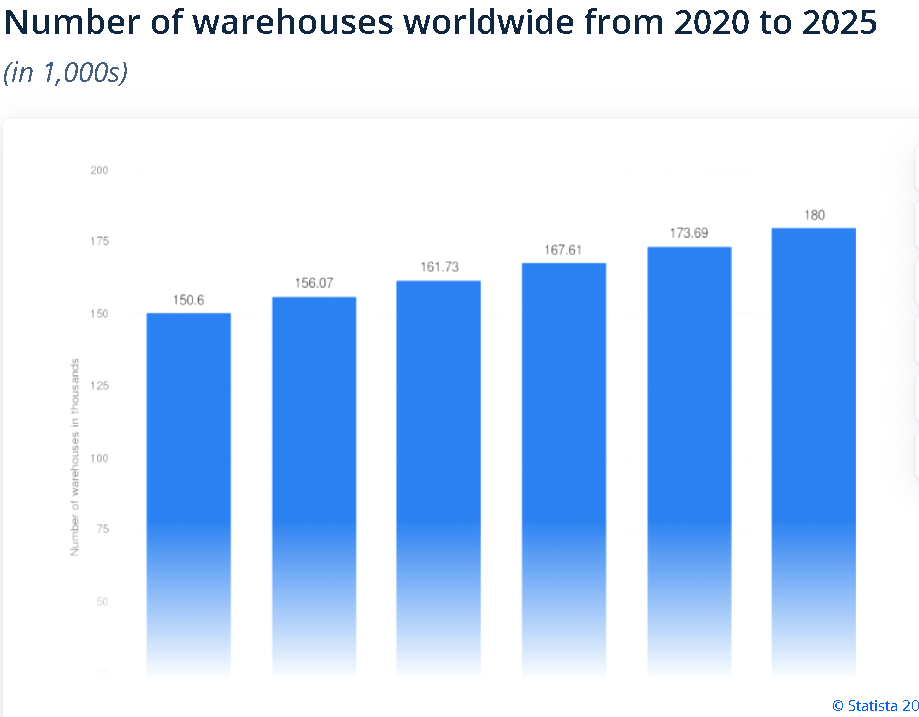
To put it simply, a data warehouse is a centralized platform that accepts, stores, and analyzes data from multiple sources. In particular, it deals with:
- Structured data. It’s the organized type of data that includes tables with clear-cut columns; a database or a spreadsheet is a good example;
- Semi-structured data. This type of data is organized only to an extent: it includes emails, XML files, etc. — in other words, all the things that have no strict, universal formatting.
Due to the growing global volume of information, the number of data warehouses is expected to reach about 180,000 in 2025. The warehouses handle historical data by dividing it into clear subject areas, tracking changes made over time, and displaying everything in a comprehensive format.
Data Warehouses vs. Databases: When to Choose What?
Some people confuse data warehouses with databases. True, they both store information, but the core principles of their work differ greatly.
If you’re interested in historical data analysis, then picking a data warehouse is the best decision. You’ll be able to analyze everything through various periods, see patterns, and get other valuable insights. Databases are simpler, and they’re mostly concerned with real-time operations.
Similarly, if you plan to handle huge volumes of data from different sources, only a powerful data warehouse will be able to meet your needs. Relational databases still have a future but their capacities are limited in comparison. For instance, if you need to make quick and simple operations like order processing and accepting transactions, a database would be a good fit, but anything more complex requires a warehouse.
Choose wisely, and remember that you can always do a switch if your business evolves.
Traditional Data Warehouses vs. Cloud Data Warehouses
Having a physical data warehouse right on the company’s premises used to be the only viable solution for business owners. Now, as cloud services have started to become increasingly accessible, people have begun to shift their attention toward them.
Let’s do a detailed comparison to give you insights into the main differences between these two types of data warehouses.
- Scalability. If you want to expand your operations, you’ll need to buy extra hardware for a traditional data warehouse; the cloud-based one, on the other hand, can be instantly scaled to the extent you want;
- Deployment. It’s difficult to deploy standard warehouses as they demand a lot of heavy equipment; cloud ones don’t have this problem as they’re hosted on cloud platforms;
- Speed. The speed of traditional warehouses depends on the quality of your hardware, while cloud-based platforms work at all times — you just need a strong Internet connection for access;
- Cost. Standard warehouses require plenty of costs because all the equipment is expensive; cloud platforms are costly, too, but you pay only for the space and things you require;
- Maintenance. You’ll need an entire IT team to manage your traditional warehouse, while the cloud platform is handled by a cloud provider.
It’s clear that cloud-based data warehouses offer far more advantages to their users, so they should be your first choice.
5 Best Data Warehouses in 2025
So, what warehouses are perfect for modern businesses? We prepared a list of 5 options. Check each of them out to get all the knowledge and decide which option will serve you best.
Amazon Redshift
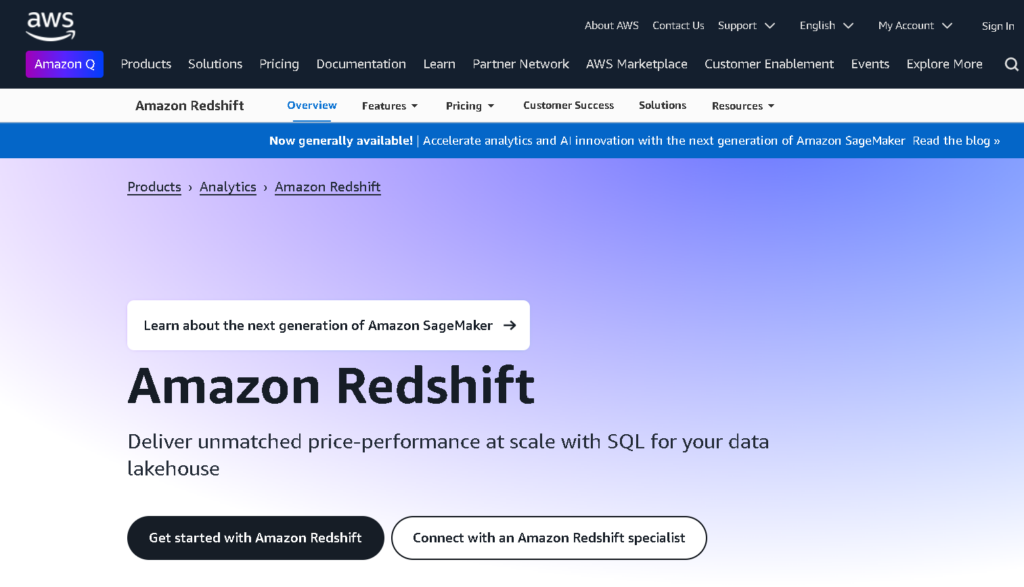
Amazon Redshift is a fully managed cloud warehouse that is perfect for businesses in need of high-performance analytics. So, if you work with endless reports and there is a lot of data to analyze, Amazon Redshift can become a quick and effective solution. It can process huge volumes of data, delivering 7 times more throughput than the majority of its competitors.
In addition, Redshift can be fully integrated with all other Amazon Web Services, which is a definite advantage, considering how popular Amazon’s products tend to be. Here are the other features your business might benefit from:
- Extra fast performance. Redshift uses columnar storage, which allows it to look for relevant info at record speed;
- Limitless scalability. Business owners can expand their storage or make it smaller based on how much computing power they need at the moment;
- Easy to use. Redshift functions on an SQL basis: this is one of the simplest and most convenient programming languages;
- Uses SQO. The fact that Redshift uses Smart Query Optimization means that it’s capable of presenting the most relevant search results even faster;
- App-building potential. You can create a customized app to handle the petabytes of your business data since Redshift supports integration with Amazon Bedrock, a platform for AI app building.
What about the prices? This is another strong point of Amazon Redshift and cloud-based warehouses in general. Its clients pay as they go: there is no need to enter long-term agreements or pay for services in bulk when you don’t need at least half of them.
The starting price is just $0.25 per hour for one node, a so-called building block that stores your info. People who become long-term clients get excellent discounts, with some of them reaching as much as 75%.
If you’ve never tried Amazon Redshift before, you can get a $300 credit. The only condition is that you have to use it within the next 90 days. This warehouse remains the most popular one for a good reason.
Google BigQuery
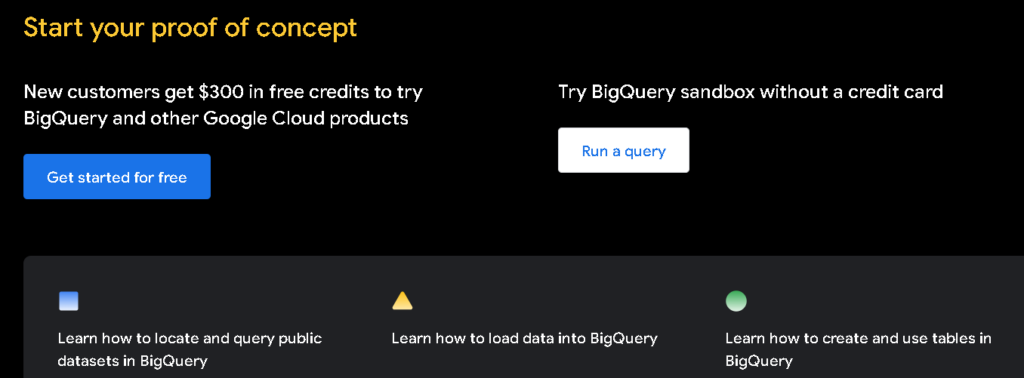
BigQuery from Google is a worthy competitor of Amazon Redshift. It’s also a cloud-based, serverless warehouse, and it offers an in-depth analysis of tons of data. You just have to upload everything, and your analysis will start right away.
Take a look at Google BigQuery’s key benefits:
- Real-time data streaming. BigQuery allows creating live dashboards, as the data is subjected to an analysis from the moment of its arrival;
- Integration with Google tools. This warehouse works with other Google tools, from Looker to AI/ML;
- Multi-cloud support. While it’s preferable to use Google Cloud with BigQuery, it’s not necessary: you can choose any other cloud storage platform as well;
- Fast response. This warehouse uses Google’s smart technology known as Dremel, which boosts the speed of query responses.
The price of Google BigQuery is pretty affordable. You have to pay $6.25 per TiB scanned; each first TiB used at the start of a month comes free of charge. In addition, you can use 10 GB to store your data completely for free — it’s a bonus for new users.
The perks don’t end here, as Google decided to follow Amazon’s example and offer $300 in free credits to its potential customers. You can explore how this cloud warehouse works without spending a cent before deciding if it deserves your money.
Snowflake
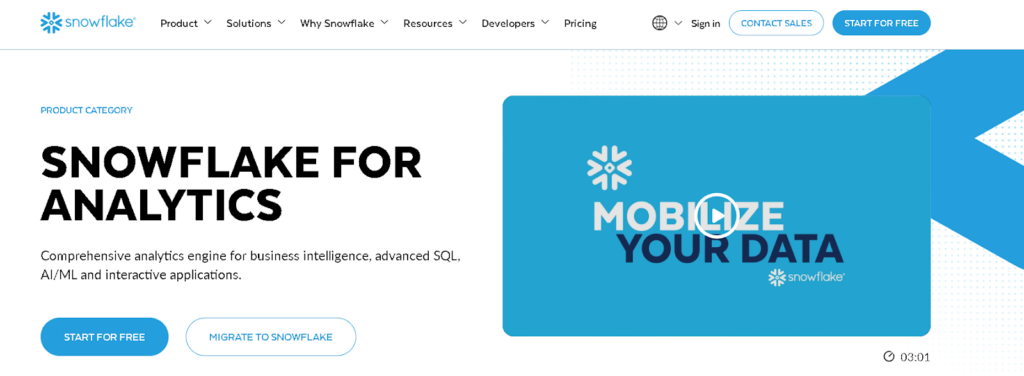
Snowflake is a cloud-based data warehouse that supports geospatial and predictive analytics. It operates based on three large cloud platforms, namely AWS, Azure, and Google Cloud, which increases its reliability.
Like the warehouses above, Snowflake requires you to pay strictly for the services and storage you use. This helps save your money and boosts your business’s productivity. Other important features worth mentioning include:
- Automatic scaling. If you expected to use a certain amount of power but ended up requiring more of it, Snowflake will adjust to your changed needs automatically and in real time;
- Data sharing. By using Snowflake, you can easily collaborate with other companies due to simplified data sharing;
- Automatic back-ups. Snowflake stores all the data you introduce to it, so even if you end up deleting or losing something, this warehouse will instantly locate it;
- App-building potential. Due to instant integration, you can use Snowflake Cortex AI to create AI applications according to your needs.
Since Snowflake uses the pay-per-use approach, its rates are more than affordable. The starting package costs $2 per credit, and it offers access to core platform functionality. The enterprise-level package is worth $3 per credit: the difference is that by paying for it, you can use multi-cluster compute and enjoy granular governance.
The business-critical package costs $4 per credit. It comes with extra disaster recovery functionality and provides access to private connectivity. Unfortunately, there are no discounts for new users, but you can use a 30-day free trial.
Microsoft Azure Synapse Analytics
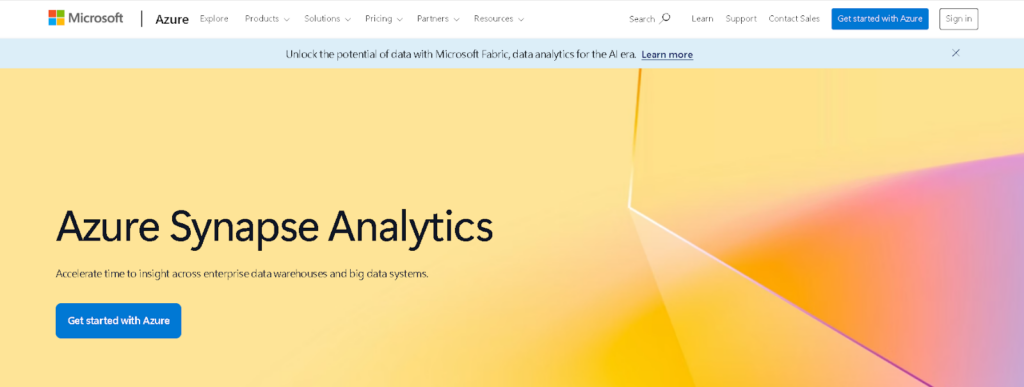
Azure Synapse belongs to Microsoft, so apart from processing impressive volumes of data, it can also be integrated with other Microsoft products, including Power BI and Azure Machine Learning. Apart from this, it has the following benefits:
- Multiple computing options. You can pay per query or order a provisioned mode with pre-set resources — this option is ideal for businesses with a consistent workload;
- Offers extra security. This warehouse guarantees advanced data masking, and it provides both column- and row-level security to its users;
- Works with different types of data. Azure Synapse can process both small and big data, so you can use it for various purposes;
- Supports a variety of data sources. Since Azure Synapse is flexible, it can work with NoSQL, cloud, and even on-premises databases.
This data warehouse is more expensive, but it offers a wide range of packages to its customers. The price depends on how many synapse commit units (SCU) you need. SCU is a unit of measure for the data you need replicated. The first tier includes 5K SCUs, and it costs $4,700; the most expensive tier entails the usage of 360,000 SCUs, and its price stands at $259,200.
There are discounts for first-time clients: the first package has a 6% discount, while the last one will help you pay 28% less. If you’re interested in a personalized offer, you can speak to a sales specialist — the contact button is located right on the page detailing the pricing. Together, you’ll be able to figure something out.
IBM Db2 Warehouse
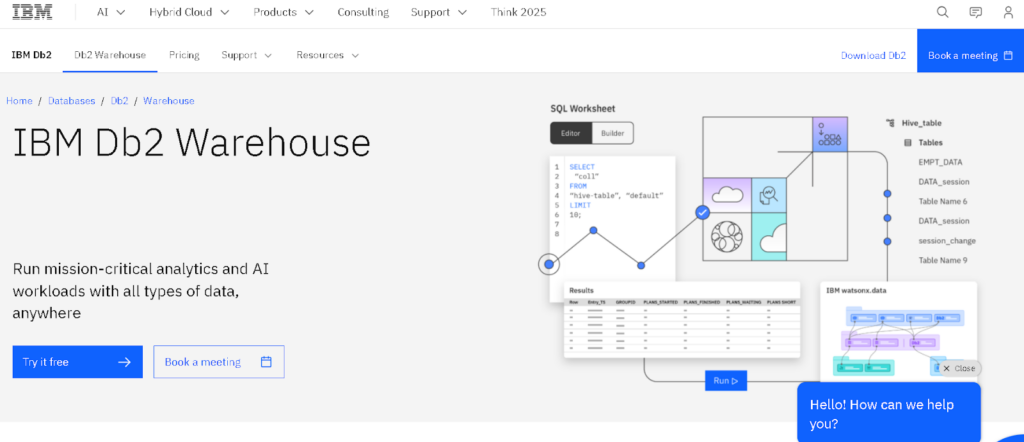
This warehouse is built on the SQL engine of IBM, and it offers advanced in-memory processing of information. You can use it for traditional business analytics and AI workloads at the same time. Like Microsoft’s warehouse, IBM Db2 can connect to an on-premises, cloud, or hybrid cloud environment depending on your needs.
While IBM Db2 doesn’t have the most modern website, it’s still a useful system that can fulfill any data requests. You can integrate it with other products from these developers, including Cloud Pak for Data. Have a look at its common features:
- Built-in AI learning. AI-driven analytics allow the warehouse to process all the data accurately and find new patterns after every shift or addition;
- Enterprise-level security. Apart from applying the usual security mechanisms, IBM Db2 offers advanced encryption and access controls to its users;
- Quick query execution. This data warehouse relies on parallel processing technologies to deliver instant results;
- Federated querying. You can integrate data even if it’s spread across many sources, from relational databases to data lakes and NoSQL stores.
IBM Db2 is more on the expensive side. You can use its services by subscribing to the packages it offers. The starting price is $1,373 per month, with bills coming for every hour; if this sum doesn’t cover your usage, the difference will be transferred to the next month.
There is a free trial that presupposes a credit of $1000 for new customers. IBM Db2 is relatively easy to use, and if you face any issues, you can contact support for help.
Choosing an Ideal Warehouse
The modern data warehouse market has plenty of options to choose from. Consider them based on their type, features, cost, and scalability. Select the warehouse that can meet all of your needs without punching a hole in your budget.
It’s always better to go for cloud-based selections as they come with more opportunities. Check out the options you found in the list above, and even if none of them work for you, keep looking. Uncover everything you can about a warehouse before paying money for it.
Posted in blog, Web Applications
Alex Carter
Alex Carter is a cybersecurity enthusiast and tech writer with a passion for online privacy, website performance, and digital security. With years of experience in web monitoring and threat prevention, Alex simplifies complex topics to help businesses and developers safeguard their online presence. When not exploring the latest in cybersecurity, Alex enjoys testing new tech tools and sharing insights on best practices for a secure web.
